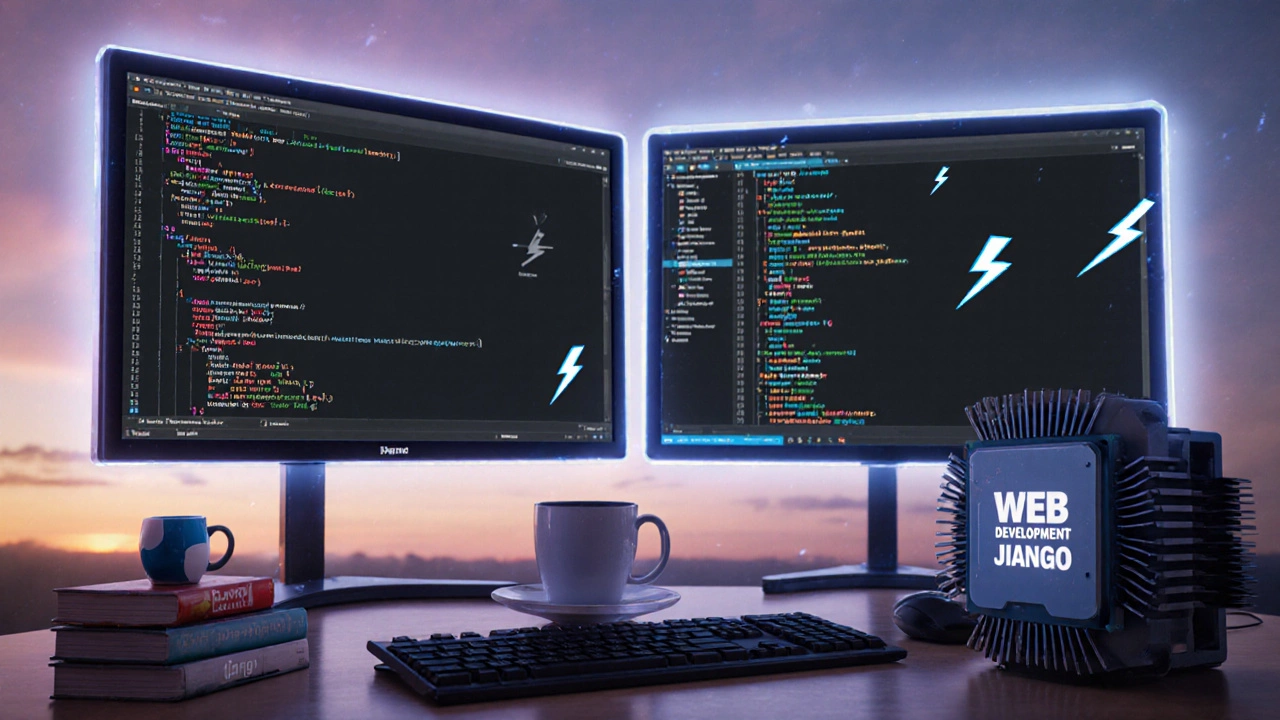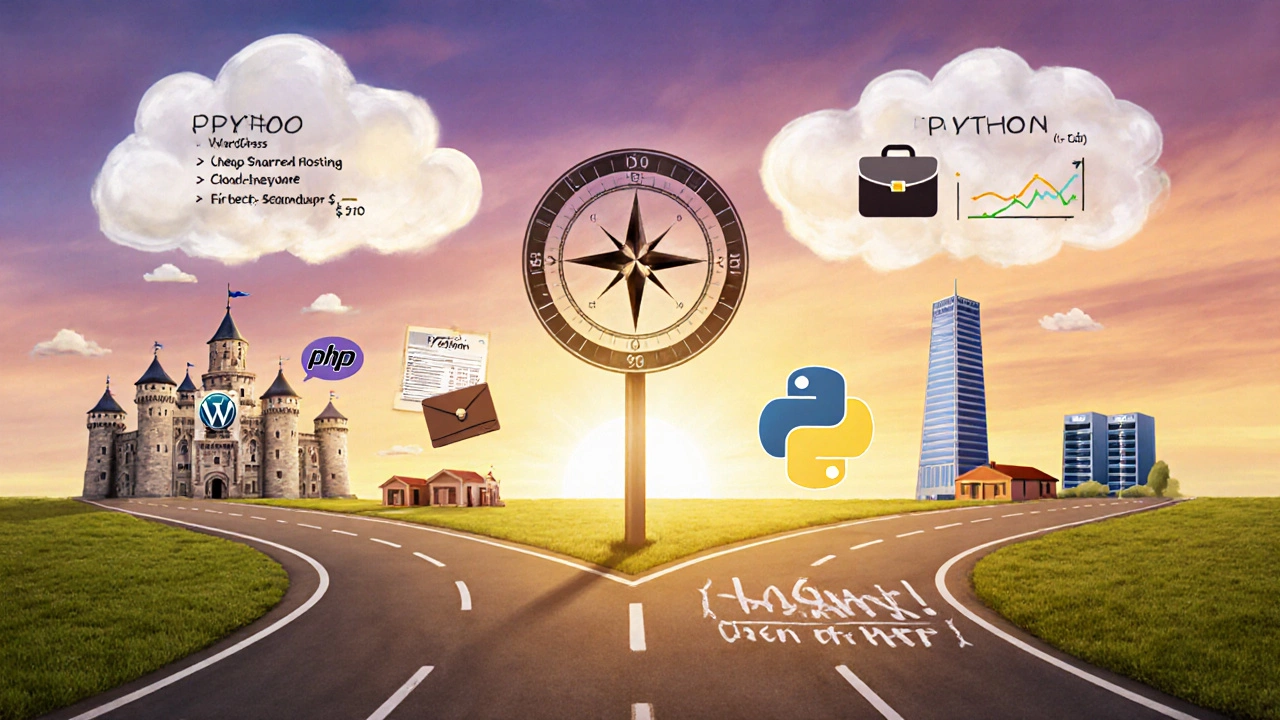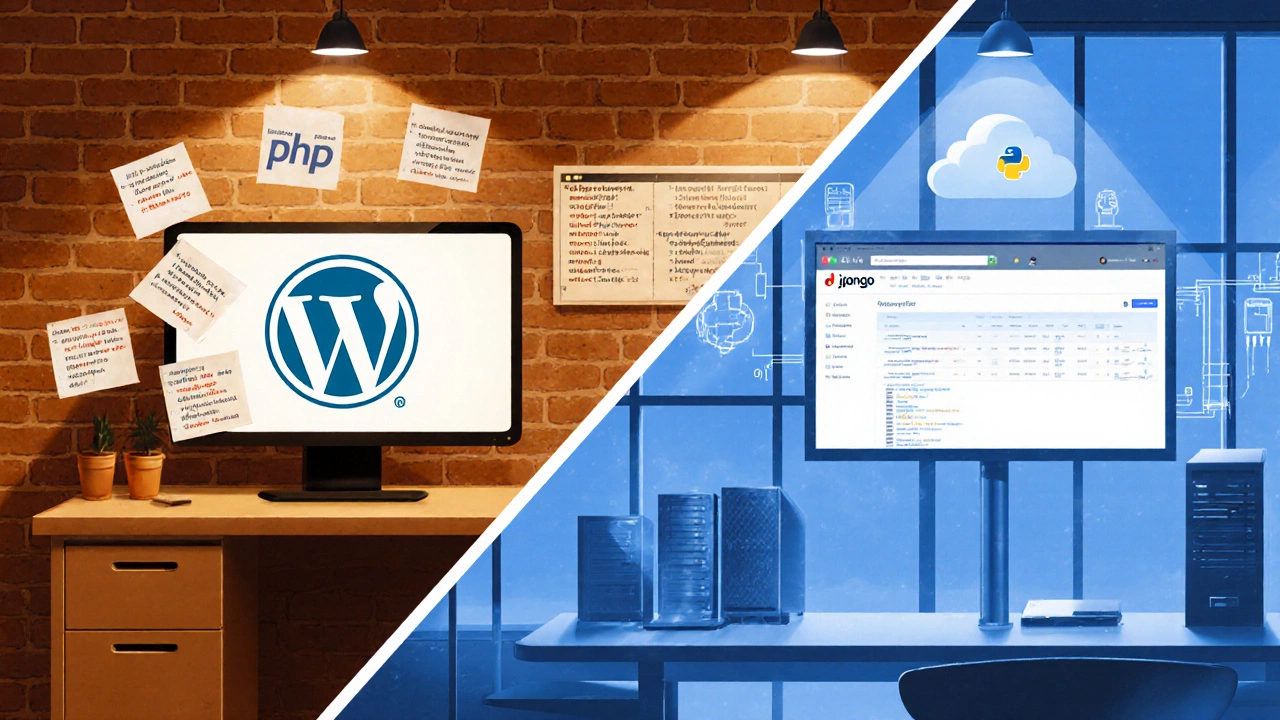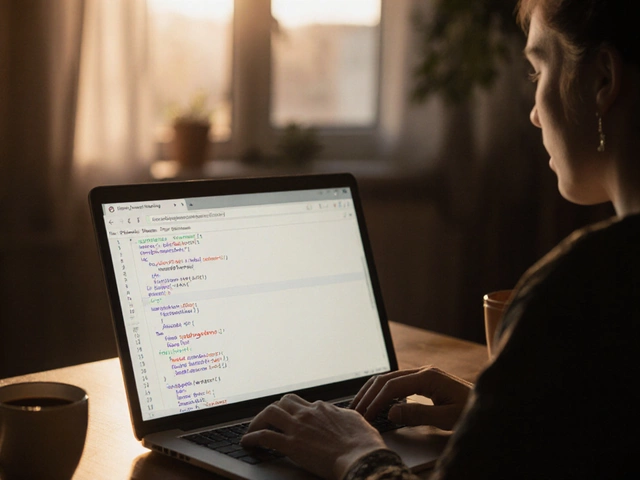PHP vs Python Comparison Tool
This tool helps you decide whether PHP or Python is better for your next project based on your specific priorities. Select the criteria that matter most to you, and we'll provide a recommendation.
Select Your Priorities
Check the criteria that are most important for your project or career goals:
PHP Recommendation
This language is best for you if:
- Building WordPress sites or maintaining legacy LAMP stack applications
- Needing to use low-cost shared hosting
- Working with CMS platforms like Drupal or Magento
- Joining PHP-focused agencies or e-commerce teams
PHP offers strong support for content management systems and is ideal for developers who need to maintain legacy codebases or work on cost-sensitive projects.
Python Recommendation
This language is best for you if:
- Building APIs or data pipelines
- Working with AI/ML or scientific applications
- Needing to rapidly prototype with clean, readable code
- Targeting growth industries like fintech or SaaS
Python excels in modern development scenarios with its strong data science capabilities, clean syntax, and thriving ecosystem for building APIs and complex applications.
Quick Takeaways
- PHP shines in WordPress, legacy codebases, and shared‑hosting environments.
- Python offers cleaner syntax, strong data‑science libraries, and a thriving modern web ecosystem.
- If you aim for rapid SaaS or API work, Python usually gives a smoother start.
- Choosing the right language depends on job market demand in your region, existing projects you’ll maintain, and the kind of apps you want to build.
- Both languages are mature, have massive communities, and can power high‑traffic sites when paired with proper tooling.
Why the Choice Matters
Ever stared at a job posting that says “backend developer (PHP or Python)” and wondered which skill will actually move your career forward? The answer isn’t a simple "PHP wins" or "Python wins"; it’s about matching the language’s strengths to the problems you want to solve.
Backend development is the engine room of any web app-handling data storage, business rules, and communication with front‑end interfaces. The language you pick shapes how quickly you can prototype, how easy it is to find help, and even how much your hosting costs.
Meet the Contenders
When it comes to backend development, PHP is a server‑side scripting language that’s been powering web applications since the mid‑1990s. It started as a simple way to embed code in HTML and has grown into a full‑featured language with modern features like type declarations, arrow functions, and a robust ecosystem of frameworks.
On the other side, Python is a high‑level, interpreted language famous for its readable syntax and versatility across web, data science, automation, and more. While it began as a general‑purpose language, frameworks like Django and Flask have turned it into a serious backend contender.
Both languages are open‑source, cross‑platform, and have millions of developers worldwide. The real difference lies in their ecosystems, performance profiles, and typical use cases.
Framework Landscape
If you think of a language as a toolbox, frameworks are the power tools that speed up development. Here are the most popular choices for each language:
- Laravel - The "Ruby on Rails of PHP". Offers elegant syntax, built‑in authentication, queues, and a vibrant package ecosystem.
- Symfony - A modular, enterprise‑grade framework used by Drupal and many large PHP projects.
- Django - Batteries‑included Python framework with an admin panel, ORM, and strong security defaults.
- Flask - A lightweight micro‑framework that lets you add only what you need, perfect for APIs and small services.
Choosing a framework often dictates which language feels more comfortable. Laravel’s expressive syntax makes PHP feel modern, while Django’s "convention over configuration" style gives Python a very clean development experience.
Performance and Scalability
Both languages run on interpreted runtimes, but they differ in raw speed and how they handle concurrency.
- PHP - Recent versions (PHP 8.2) introduced Just‑In‑Time (JIT) compilation, narrowing the gap with compiled languages. Paired with an opcode cache like OPcache, typical request‑response cycles are fast enough for most web traffic.
- Python - CPython (the standard interpreter) is a bit slower on CPU‑bound tasks. However, async frameworks (e.g., FastAPI, AIOHTTP) let Python handle thousands of concurrent connections efficiently.
If your app is I/O‑heavy-think real‑time chat or streaming APIs-Python’s async capabilities can outperform traditional PHP setups. For CPU‑intensive operations, both languages usually offload work to background workers (e.g., Laravel Queues, Celery) written in faster languages like C or Go.

Job Market Snapshot (2025)
According to the 2025 Stack Overflow Developer Survey, Python ranks #2 in most‑wanted languages, while PHP holds steady in the top‑10 for legacy and CMS work. In the UK, Python jobs grew 18 % year‑over‑year, driven by fintech, AI, and cloud startups. PHP roles grew modestly, mostly tied to WordPress agencies and e‑commerce platforms.
Freelancers also see a split: clients needing WordPress sites pay well for PHP expertise; SaaS founders often look for Python developers to build APIs and data pipelines.
Tooling and DevOps
Modern development pipelines blur the lines between languages, but each has its native conveniences.
- Package Management: Composer (PHP) vs pip/Poetry (Python). Both resolve dependencies cleanly, but Composer’s autoloading feels more integrated for web apps.
- Testing: PHPUnit (PHP) vs pytest (Python). Both frameworks are mature; Python’s pytest is praised for its simple fixtures.
- Containers: Official Docker images exist for both. Docker makes it trivial to spin up a consistent environment regardless of language.
- CI/CD: GitHub Actions, GitLab CI, and CircleCI support both ecosystems out of the box.
In practice, the choice of language rarely blocks you from adopting modern DevOps practices.
Community, Learning Resources, and Support
Both PHP and Python boast massive communities, but the tone and focus differ.
- PHP - Stack Overflow answers are plentiful for WordPress, Laravel, and classic LAMP stack issues. The community excels at solving deployment quirks on shared hosting.
- Python - Communities around data science, AI, and web APIs are very active. Tutorials on sites like Real Python, freeCodeCamp, and official docs are consistently updated.
When you’re learning, having up‑to‑date tutorials matters. Python’s documentation is often cited as a gold standard, while PHP’s docs have improved dramatically in recent years.
Cost of Hosting and Infrastructure
If you’re a solo developer or small agency, hosting costs can tip the scales.
- Traditional PHP apps run comfortably on cheap shared‑hosting plans (often < $5/month).
- Python web apps typically require a VPS or managed platform (e.g., Heroku, Render) because they need a WSGI server like Gunicorn, which adds a few dollars to the monthly bill.
However, serverless options (AWS Lambda, Google Cloud Functions) now support both runtimes, letting you pay per request and keep costs low.

Decision Matrix
| Aspect | PHP | Python |
|---|---|---|
| Syntax simplicity | Improved in PHP 8, but still a mix of old and new patterns | Very clean, whitespace‑driven, great for beginners |
| Learning curve | Moderate; easier if you already know HTML | Gentle; many resources for non‑programmers |
| Ecosystem for web | Laravel, Symfony, WordPress, Drupal | Django, Flask, FastAPI, Pyramid |
| Performance (raw) | PHP 8 JIT makes it competitive | CPython slower; async frameworks help latency |
| Job market (2025, UK) | Steady demand in agencies, CMS work | Strong growth in fintech, AI, SaaS |
| Typical use cases | Content sites, e‑commerce, legacy apps | APIs, data pipelines, scientific apps |
| Hosting cost | Cheap shared hosting available | Usually needs VPS or managed PaaS |
Tips for Making the Switch
Whatever you pick, you’ll likely run into the other language at some point. Here are quick hacks to keep your skill set flexible:
- Learn the basics of HTTP, REST, and JSON. Those concepts are language‑agnostic.
- Practice building a tiny CRUD app in both Laravel and Django. Seeing the same feature in two stacks cements the concepts.
- Use version control (Git) consistently. It abstracts away language‑specific quirks.
- Dockerize your project early. A Docker file lets you swap runtimes without reinstalling everything.
- Contribute to an open‑source project in the other language. Even a small PR teaches you idiomatic patterns.
Bottom Line: Which One Should You Learn?
If you’re aiming to land a job building WordPress sites, maintain legacy LAMP applications, or need the cheapest possible hosting, start with PHP. Laravel will give you modern tooling while keeping you compatible with the huge PHP job pool.
If you want to work on data‑driven APIs, machine‑learning pipelines, or join fast‑growing startups that favor clean code and rapid prototyping, go with Python. Django or FastAPI will let you ship a production‑grade service in weeks.
Many developers eventually learn both-nothing prevents you from adding Python to your resume after you’ve mastered PHP, or vice‑versa. The key is to pick one, build real projects, and then expand.
Next Steps
- Pick a starter tutorial: "Build a Blog with Laravel" or "Create a To‑Do API with Flask".
- Set up a local dev environment using Docker.
- Deploy a simple app to a free tier (Laravel on Fly.io, Python on Render).
- Add a second language after you’re comfortable with the first.
Is PHP still relevant in 2025?
Absolutely. PHP powers over 78 % of the web, mainly through WordPress and Magento. Its ecosystem continues to modernize with features like JIT, typed properties, and a vibrant package manager (Composer). If you work with CMSs or legacy LAMP stacks, PHP is still a solid choice.
Can I use the same hosting provider for both PHP and Python?
Yes. Most VPS or cloud providers (DigitalOcean, AWS, Linode) let you install both runtimes side‑by‑side. Managed platforms like Render or Fly.io also support multiple buildpacks, so you can deploy a Laravel app and a FastAPI service on the same account.
Which language has a better community for beginners?
Both have strong communities, but Python’s official documentation and resources like Real Python are often praised for clarity. PHP’s community excels in practical, deployment‑focused advice, especially for shared‑hosting scenarios.
How do salaries compare for PHP vs Python developers in the UK?
2025 salary surveys show Python developers averaging £55k‑£70k, reflecting demand in fintech and AI. PHP developers typically earn £45k‑£60k, with higher rates in specialist WordPress or e‑commerce roles.
Is it hard to switch from PHP to Python after a few years of experience?
Not at all. The concepts-variables, control flow, OOP-are the same. The biggest adjustment is Python’s whitespace‑based syntax. A short “learn the syntax” sprint and a few practice projects usually smooth the transition.





